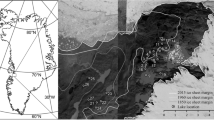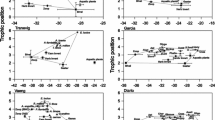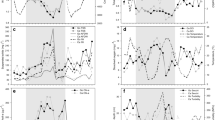Abstract
Energetic and dynamic constraints have been proposed as rival factors in determining food-web structure. Food-web length might be controlled either by the amount of energy entering the web (energetic constraints) or by time span between consecutive disturbances relative to time needed to build up a population (dynamic constraints). Dynamic constraints are identified with processes functioning at a regional scale such as climate, lithology and hydrogeology. Energetic constraints are related with processes operating both at a regional and a local scale. We studied the contribution of energetic constraints to food-web organization in two temporary saline lakes with similar dynamic constraints. Lakes were sampled fortnightly during two hydroperiods (1994/1995 and 1995/1996). Differences in energetic constraints between lakes result in divergent assemblages of primary producers. Consumer assemblages in both lakes, however, are similar in species composition although differ in total biomass and species abundances. Food-webs are short with a high proportion of omnivores. To simulate an increase in the energy input entering to these systems, an addition of nutrients (to a final concentration of 100 μgċl−1 P-PO4 3-) was done in mesocosms placed within the lakes in order to obtain an increase in the phytoplankton biomass. No significant response to nutrient enrichment was found in food-web structure (composition, density or biomass).
Similar content being viewed by others
References
Alcorlo, P., 1999. Redes tróficas en lagunas salinas temporales de la comarca de Los Monegros (Zaragoza). PhD Thesis. Universidad Autónoma de Madrid: 300 pp+Appendix.
Alcorlo, P., P. Díaz, J. Lacalle, A. Baltanás, M. Florín, M. C. Guerrero & C. Montes, 1997. Sediment features, primary producers and food web structure in two shallow temporary lakes (Monegros, Spain). Wat. Air Soil Poll. 99: 681–688.
Aminot, A. & M. Chaussepied, 1993. Manuel des chimiques en milieu marin. CNES, Paris.
Andersen, J.M., 1976. An ignition method for determination of total phosphorus in lake sediments. Wat. Res. 10: 329–331.
A.P.H.A., 1991. Métodos normalizados para el análisis de aguas potables y residuales. Díaz de Santos, S.A., Madrid.
Briand, F., 1983. Environmental control of food web structure. Ecology 64: 253–263. Table 6. Total biomass (mg C · m-2) allocated to each taxa Lake Date Anostracans Nematods Ostracods Rotifers Algae Piñol 1/17/96 157.34 0.48 26.52 0.01 0.98 2/2/96 282.18 1.25 139.77 0.13 2.69 2/17/96 130.73 2.19 45.66 0.87 3.86 3/1/96 103.35 2.67 41.24 1.01 2.40 3/13/96 71.55 4.24 100.55 0.64 1.62 Muerte 1/17/96 0.87 1.58 0.90 0.027 2.63 2/2/96 0.01 0.09 0.99 0.04 18.26 2/17/96 0.008 0.23 33.19 0.24 41.89 3/1/96 - 0.14 8.11 0.14 6.69 3/13/96 - 0.18 5.76 0.02 3.71 Table 7. Results of analysis of variance of biomass in relation to phosphorus enrichment Consumers Phytoplankton All Treatment Date Treatment Treatment Date Treatment Treatment Date Treatment × Date × Date × Date La Muerte df 1 4 4 1 4 4 1 4 4 F-ratio 0.4691 2.4836 0.8209 8.6637 21.9529 1.219 3.1521 2.3764 1.0968 p 0.5012 0.0766 0.5271 0.008 <0.0001 0.3341 0.091 0.0864 0.3852 Piñol df 1 4 4 1 4 4 1 4 4 F-ratio 2.3538 0.7338 0.1627 0.0114 5.9936 1.4479 2.3793 0.7095 0.1592 p 0.1406 0.5797 0.9548 0.9163 0.003 0.2591 0.1386 0.5949 0.9565
Cohen, J. E., 1989. Food webs and community structure. In Levin, S. A. (eds), Perspectives in Ecological Theory. Princeton University Press, Princeton, N.J.: 181–202.
Cohen, J. E. & C. M. Newman, 1985. A stochastic theory of community food webs I. models and aggregated data. Proc. r. Soc. Lond. Ser.B. 224: 421–448.
Comín, F., R. Julià & P. Comín, 1991. Fluctuations, the key aspect for the ecological interpretation of saline lake ecosystems. Oecologia Aquat. 10: 127–135.
Comín, F., X. Rodó & P. Comín, 1992. Lake Gallocanta (Aragón, NE.Spain), a paradigm of fluctuations at different scales of time. Limnetica 8: 79–86.
Díaz Palma, P., 1998. Producción primaria y su relación con las fluctuaciones asociadas al ciclo hidrológico en lagunas salinas de la Depresión del Ebro (NE, España). PhD Thesis., Universidad Autónoma de Madrid: 221 pp.
Downing, J. A. & F. H., Rigler, 1984. A Manual on Methods for the Assessment of Secondary Productivity in Fresh Waters. 2nd edn. Blackwell Scientific Publications, Great Britain: 501 pp.
Feller, R. J. & R. M. Warwick, 1988. Energetics. In Higgins, R. P. & H. Thiel (eds), Introduction to the Study of Meiofauna. Smithsonian Institution, Washington, D.C.: 181–196.
Florín, M. & C. Montes, 1998. Fluctuations of hydrochemical equilibrium in temporary saline lagunas with different primary producer communities. Verh. int. Ver. Limnol. 26: 1387–1391.
Fretwell, S. D., 1977. The regulation of plant communities by the food chains exploiting them. Perspectives in Biology and Medicine 20: 169–185.
Fretwell, S. D., 1987. Food chain dynamics: the central theory of ecology? Oikos 50: 291–301.
Guerrero, M. C. & R. De Wit, 1992. Microbial mats in the inland saline lakes of Spain. Limnetica 8: 197–204.
Hairston, N. G. Jr. & N. G. Sr. Hairston, 1993. Cause-effect relationships in energy flow, trophic structure, and interspecific interactions. Am. Nat. 142: 379–411.
Hammer, U. T., 1986. Saline lake ecosystems of the world. Dr W. Junk Publishers, Dordrecht, The Netherlands: 615 pp.
Havens, K. E., 1994. Experimental perturbation of a freshwater plankton community: a test of hypotheses regarding the effects of stress. Oikos 69: 147–153.
Hutchinson, G. E., 1959. Homage to Santa Rosalia orWhy are there so many kinds of animals? Am. Nat. 93: 145–158.
Instituto Nacional de Meteorología, 1995. Valores normales y estadísticos de estaciones principales (1961-1990). Observatorio metereológico de Zaragoza ‘Aeropuerto’. Ministerio de Obras PÚblicas, Transporte y Medio Ambiente, España: 56 pp.
Javor, B., 1989. Hypersaline environments. Microbiology and biogeochemistry. Springer-Verlag, New York, U.S.A.: 328 pp.
Jenkins, B., R. L. Kitching & S. L. Pimm, 1992. Productivity, disturbance and food web structure at a local spatial scale in experimental container habitats. Oikos 65: 249–255.
Lawton, J. H. & P. H. Warren, 1988. Static and dynamic explanations for patterns in food webs. Trends Ecol. Evol. 3: 242–245.
Martinez, N. D., 1991. Artifacts or attributes? Effects of resolution of the Little Rock Lake food web. Ecol. Monogr. 61: 367–392.
Martinez, N. D., 1992. Constant connectance in community food webs. Am. Nat. 139: 1208–1218.
Martinez, N. D. & J. H. Lawton, 1995. Scale and food-web structure - from local to global. Oikos 73: 148–154.
May, R. M., 1986. The search for patterns in the balance of nature: advances and retreats. Ecology 67: 1115–1126.
Oksanen, L., 1983. Trophic exploitation and arctic phytomass patterns. Am. Nat. 122: 45–52.
Oksanen, L., 1991. Trophic levels and trophic dynamics: a consensus emerging? Trends Ecol. Evol. 6: 58–90.
Oksanen, L., S. Fretwell, J. Aruda & P. Niemela, 1981. Exploitation ecosystems in gradients of primary productivity. Am. Nat. 118: 240–261.
Paine, R. T., 1980. Food webs: linkage, interaction strenght and community infrastructure. J. anim. Ecol. 49: 667–686.
Paine, R. T., 1988. Food webs: road maps of interactions or grist for theoretical deveplopment? Ecology 69: 1648–1654.
Paine, R. T., 1992. Food-web analysis through field measurement of per capita interaction strength. Nature 355: 73–75.
Pimm, S. L., 1982. Food Webs. Chapman & Hall, London: 218 pp.
Pimm, S. L., 1988. Energy flow and trophic structure. In Pomeroy, L. R. & J. J. Alberts (eds), Concepts of Ecosystem Ecology. Springer-Verlag, New York: 263–278.
Pimm, S. L. & R. L. Kitching, 1987. The determinants of food chain lenghts. Oikos 50: 302–307.
Pimm, S. L. & J. H. Lawton, 1977. The number of trophic levels in ecological communities. Nature 268: 329–331.
Pimm, S. L., J. H. Lawton & J. E. Cohen, 1991. Food web patterns and their consequences. Nature 350: 669–674.
Polis, G. A & D. R. Strong, 1996. Food web complexity and community dynamics. Am. Nat. 147: 813–846.
Pueyo, J. J., 1980. Procesos diagenéticos observados en las lagunas tipo playa de la zona de Bujaraloz-Alcañiz (provincias de Zaragoza y Teruel). Revista Investigaciones Geológicas 34: 195–207.
Pueyo, J. J. & M. Inglés, 1987. Magnesite formation in recent playa lakes, Los Monegros, Spain. In Marshall, J. D. (eds), Diagenesis of Sedimentary Sequences. Geological Society Special Publication: 119–122.
Quirantes, J., 1971. Las calizas en el Terciario continental de Los Monegros. Estudios Geológicos 27: 355–362.
Schneider, D. W., 1997. Predation and food web structure along a habitat duration gradient. Oecologia 110: 567–575.
Smayda, T. J., 1978. From phytoplankters to biomass. In Sournia, A. (ed.), Phytoplankton Manual. UNESCO, Paris: 273–279.
Sprules, W. G. & J. E. Bowerman, 1988. Omnivory and food chain length in zooplankton food webs. Ecology 69: 418–426.
Sterner, R. W., A. Bajpai & T. Adams, 1997. The enigma of food chain length: absence of theoretical evidence for dynamic constraints. Ecology 78: 2258–2262.
Thièry, A., 1987. Les crustaces branchiopodes anostraca, notostraca et conchostraca des milieux limniques temporaires (dayas) au maroc. Taxonomie, biogeographie, ecologie. Tesis Doctoral, Faculte des Sciences et techniques de St Jerôme, Universite de Droit d'Economie et des Sciences d'Aix-Marseille: 406 pp.
Warren, P. H., 1994. Making connections in food webs. Trends Ecol. Evol. 9: 136–141.
Warren, P. H., 1995. Estimating morphologically determined connectance and structure for food webs of freshwater invertebrates. Freshwat. Biol. 33: 213–221.
Wetzel, R. G. & G. E., Likens, 1991. Limnological Analyses. Springer-Verlag, New York: 391 pp.
Wieser, W., 1960. Benthic studies in Buzzards Bay. II. The meiofauna. Limnol. Oceanogr. 5: 121–137.
Yodzis, P., 1981. The structure of assembled communities. J. Theor. Biol. 289: 674–676.
Yodzis, P., 1984. The structure of assembled communities. II. J. Theor. Biol. 92: 115–126.
Author information
Authors and Affiliations
Rights and permissions
About this article
Cite this article
Alcorlo, P., Baltanás, A. & Montes, C. Food-web structure in two shallow salt lakes in Los Monegros (NE Spain): energetic vs dynamic constraints. Hydrobiologia 466, 307–316 (2001). https://doi.org/10.1023/A:1014594408119
Issue Date:
DOI: https://doi.org/10.1023/A:1014594408119




